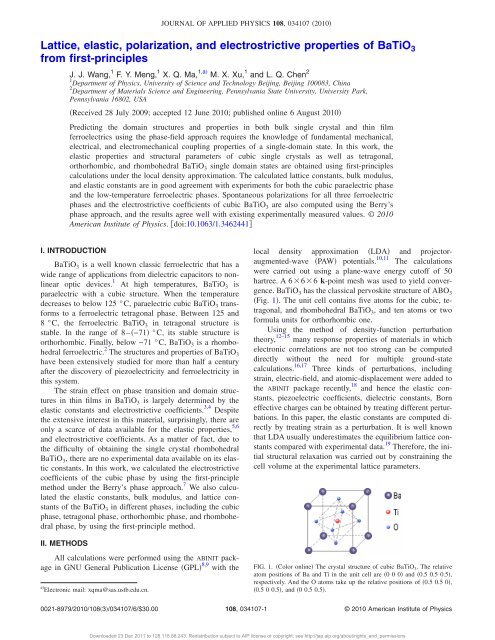Lattice, elastic, polarization, and electrostrictive ... - TheEEStory
Lattice, elastic, polarization, and electrostrictive ... - TheEEStory
Lattice, elastic, polarization, and electrostrictive ... - TheEEStory
You also want an ePaper? Increase the reach of your titles
YUMPU automatically turns print PDFs into web optimized ePapers that Google loves.
JOURNAL OF APPLIED PHYSICS 108, 034107 2010<br />
<strong>Lattice</strong>, <strong>elastic</strong>, <strong>polarization</strong>, <strong>and</strong> <strong>electrostrictive</strong> properties of BaTiO 3<br />
from first-principles<br />
J. J. Wang, 1 F. Y. Meng, 1 X. Q. Ma, 1,a M. X. Xu, 1 <strong>and</strong> L. Q. Chen 2<br />
1 Department of Physics, University of Science <strong>and</strong> Technology Beijing, Beijing 100083, China<br />
2 Department of Materials Science <strong>and</strong> Engineering, Pennsylvania State University, University Park,<br />
Pennsylvania 16802, USA<br />
Received 28 July 2009; accepted 12 June 2010; published online 6 August 2010<br />
Predicting the domain structures <strong>and</strong> properties in both bulk single crystal <strong>and</strong> thin film<br />
ferroelectrics using the phase-field approach requires the knowledge of fundamental mechanical,<br />
electrical, <strong>and</strong> electromechanical coupling properties of a single-domain state. In this work, the<br />
<strong>elastic</strong> properties <strong>and</strong> structural parameters of cubic single crystals as well as tetragonal,<br />
orthorhombic, <strong>and</strong> rhombohedral BaTiO 3 single domain states are obtained using first-principles<br />
calculations under the local density approximation. The calculated lattice constants, bulk modulus,<br />
<strong>and</strong> <strong>elastic</strong> constants are in good agreement with experiments for both the cubic paraelectric phase<br />
<strong>and</strong> the low-temperature ferroelectric phases. Spontaneous <strong>polarization</strong>s for all three ferroelectric<br />
phases <strong>and</strong> the <strong>electrostrictive</strong> coefficients of cubic BaTiO 3 are also computed using the Berry’s<br />
phase approach, <strong>and</strong> the results agree well with existing experimentally measured values. © 2010<br />
American Institute of Physics. doi:10.1063/1.3462441<br />
I. INTRODUCTION<br />
BaTiO 3 is a well known classic ferroelectric that has a<br />
wide range of applications from dielectric capacitors to nonlinear<br />
optic devices. 1 At high temperatures, BaTiO 3 is<br />
paraelectric with a cubic structure. When the temperature<br />
decreases to below 125 °C, paraelectric cubic BaTiO 3 transforms<br />
to a ferroelectric tetragonal phase. Between 125 <strong>and</strong><br />
8 °C, the ferroelectric BaTiO 3 in tetragonal structure is<br />
stable. In the range of 8–−71 °C, its stable structure is<br />
orthorhombic. Finally, below −71 °C, BaTiO 3 is a rhombohedral<br />
ferroelectric. 2 The structures <strong>and</strong> properties of BaTiO 3<br />
have been extensively studied for more than half a century<br />
after the discovery of piezoelectricity <strong>and</strong> ferroelectricity in<br />
this system.<br />
The strain effect on phase transition <strong>and</strong> domain structures<br />
in thin films in BaTiO 3 is largely determined by the<br />
<strong>elastic</strong> constants <strong>and</strong> <strong>electrostrictive</strong> coefficients. 3,4 Despite<br />
the extensive interest in this material, surprisingly, there are<br />
only a scarce of data available for the <strong>elastic</strong> properties, 5,6<br />
<strong>and</strong> <strong>electrostrictive</strong> coefficients. As a matter of fact, due to<br />
the difficulty of obtaining the single crystal rhombohedral<br />
BaTiO 3 , there are no experimental data available on its <strong>elastic</strong><br />
constants. In this work, we calculated the <strong>electrostrictive</strong><br />
coefficients of the cubic phase by using the first-principle<br />
method under the Berry’s phase approach. 7 We also calculated<br />
the <strong>elastic</strong> constants, bulk modulus, <strong>and</strong> lattice constants<br />
of the BaTiO 3 in different phases, including the cubic<br />
phase, tetragonal phase, orthorhombic phase, <strong>and</strong> rhombohedral<br />
phase, by using the first-principle method.<br />
II. METHODS<br />
All calculations were performed using the ABINIT package<br />
in GNU General Publication License GPL 8,9 with the<br />
a Electronic mail: xqma@sas.ustb.edu.cn.<br />
local density approximation LDA <strong>and</strong> projectoraugmented-wave<br />
PAW potentials. 10,11 The calculations<br />
were carried out using a plane-wave energy cutoff of 50<br />
hartree. A 666 k-point mesh was used to yield convergence.<br />
BaTiO 3 has the classical pervoskite structure of ABO 3<br />
Fig. 1. The unit cell contains five atoms for the cubic, tetragonal,<br />
<strong>and</strong> rhombohedral BaTiO 3 , <strong>and</strong> ten atoms or two<br />
formula units for orthorhombic one.<br />
Using the method of density-function perturbation<br />
theory, 12–15 many response properties of materials in which<br />
electronic correlations are not too strong can be computed<br />
directly without the need for multiple ground-state<br />
calculations. 16,17 Three kinds of perturbations, including<br />
strain, electric-field, <strong>and</strong> atomic-displacement were added to<br />
the ABINIT package recently, 18 <strong>and</strong> hence the <strong>elastic</strong> constants,<br />
piezoelectric coefficients, dielectric constants, Born<br />
effective charges can be obtained by treating different perturbations.<br />
In this paper, the <strong>elastic</strong> constants are computed directly<br />
by treating strain as a perturbation. It is well known<br />
that LDA usually underestimates the equilibrium lattice constants<br />
compared with experimental data. 19 Therefore, the initial<br />
structural relaxation was carried out by constraining the<br />
cell volume at the experimental lattice parameters.<br />
FIG. 1. Color online The crystal structure of cubic BaTiO 3 . The relative<br />
atom positions of Ba <strong>and</strong> Ti in the unit cell are 0 00 <strong>and</strong> 0.5 0.5 0.5,<br />
respectively. And the O atoms take up the relative positions of 0.5 0.5 0,<br />
0.5 0 0.5, <strong>and</strong> 0 0.5 0.5.<br />
0021-8979/2010/1083/034107/6/$30.00<br />
108, 034107-1<br />
© 2010 American Institute of Physics<br />
Downloaded 23 Dec 2011 to 128.118.88.243. Redistribution subject to AIP license or copyright; see http://jap.aip.org/about/rights_<strong>and</strong>_permissions
















